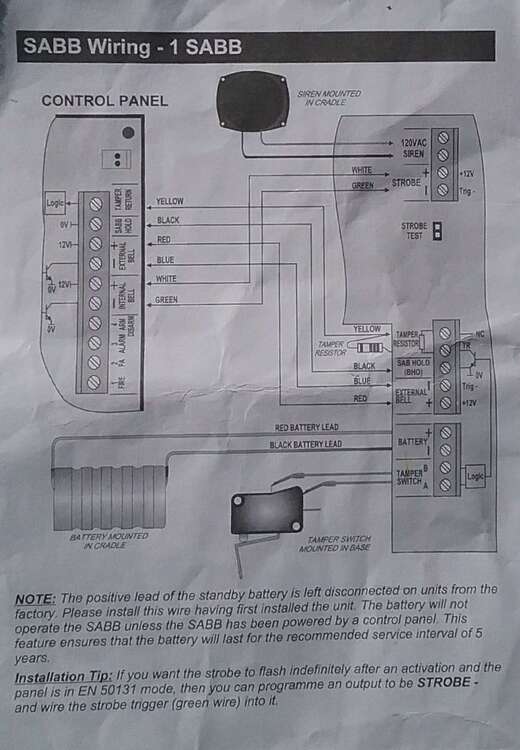-
Posts
143 -
Joined
-
Last visited
-
Days Won
1
Content Type
Profiles
Forums
Events
Downloads
Gallery
Blogs
Everything posted by Eugene's DIY Den
-

Forgotten Password and HKC GSM Q Unit
Eugene's DIY Den replied to Eugene's DIY Den's topic in !!..DIY Installers..!!
Is it possible for this unit to display codes sent to it by SMS on the alarm panel's LCD or get them relayed to a second handset to avoid this issue? -
So I forgot the password for logging into my the online account for my mobile number (I wanted to check credit) and I did "forgot password" which unfortunately sends a validation code to my SIM which is in the GSM unit. So I'm going to have to take it out and put it into a handset to get the code to change the password online. Really frustrating. When I installed the GSM unit after installing my alarm, I think I put the SIM in before I powered the GSM unit up or even the alarm board. Question is can I just pull the SIM out now with the GSM unit powered up or could it cause damage? Is it sufficient to just disable the GSM board from the engineer's menu? (9222 Disable GSM)
-

"Entry Fault" message - SW1070 Panel
Eugene's DIY Den replied to Eugene's DIY Den's topic in !!..DIY Installers..!!
So basically this message is normal and not a fault? -
So I'm still getting an "entry fault" SMS message when I open my back door and allow the entry delay to time out and the panel to activate an alarm. Is this a normal message, or due to a real fault caused by e.g. bouncing contacts and not a single clean opening of the reed switch? Wiring is good. I get three messages, "Alarm", "Entry fault", "Unset". I only expect two of these. Sometimes I get the problem with my front door too. The door and jamb are stuck and I have to shake the door to get it open, so the reed switch would alternatively open and close multiple times. I think maybe this is just a not very appropriate choice of words for the message (it's not really a "fault"). Can I turn this message off while still keeping normal reporting of faults (e.g. mains failure) in the settings for the communication board? A message about the alarm and the zone it's on and a second SMS to tell me that the alarm has been unset is sufficient.
-

SW-1070 External Bell Not Sounding
Eugene's DIY Den replied to Eugene's DIY Den's topic in !!..DIY Installers..!!
There's no movement of the sensors though, they're well fixed. What I'm wondering is what exactly "entry fault" means. -

SW-1070 External Bell Not Sounding
Eugene's DIY Den replied to Eugene's DIY Den's topic in !!..DIY Installers..!!
Connections are perfect, I always spend ages making them. No corrosion. Fault wasn't a tamper fault. -

SW-1070 External Bell Not Sounding
Eugene's DIY Den replied to Eugene's DIY Den's topic in !!..DIY Installers..!!
I notice I get an error fault sometimes when I open my front door and the alarm goes off. The frame is swollen with all the rain so the door takes a lot of tugging and pushing to pull it open. Could this be due to the contacts being repeatedly opened and closed, sending multiple pulses to the panel instead of a single open signal? -

SW-1070 External Bell Not Sounding
Eugene's DIY Den replied to Eugene's DIY Den's topic in !!..DIY Installers..!!
In case you're a burglar and hack in and remotely control the panel in the future? I presume that's what they're worried about. -

SW-1070 External Bell Not Sounding
Eugene's DIY Den replied to Eugene's DIY Den's topic in !!..DIY Installers..!!
I haven't had any false alarms since I installed mine last year. Previously I noticed that the old panel triggered when a mains plug was pulled out. Individual tampers probably also helps. The original tamper went all over the place, out to sheds and my workshop. -

SW-1070 External Bell Not Sounding
Eugene's DIY Den replied to Eugene's DIY Den's topic in !!..DIY Installers..!!
The panel I used is a pro version, I was lucky enough to get it from my electrical suppler. Apparently it's only supposed to be supplied to professional , not sure of the logic of this? Maybe they're afraid of reverse engineering? -

SW-1070 External Bell Not Sounding
Eugene's DIY Den replied to Eugene's DIY Den's topic in !!..DIY Installers..!!
I thought I was a young dude too, lol! Are you interesting in joining the Facebook group? -

SW-1070 External Bell Not Sounding
Eugene's DIY Den replied to Eugene's DIY Den's topic in !!..DIY Installers..!!
Not sure what you mean. The zone type for the internal door is "alarm" and the zone option is "inhibit". -

SW-1070 External Bell Not Sounding
Eugene's DIY Den replied to Eugene's DIY Den's topic in !!..DIY Installers..!!
The door isn't in the entry route and I want it to trigger the alarm immediately when opened, so is inhibit the correct option? The other options are access, excl from part set A, excl from part set B, double knock, soak, chime, 24 hour, perimeter and remote test. -

SW-1070 External Bell Not Sounding
Eugene's DIY Den replied to Eugene's DIY Den's topic in !!..DIY Installers..!!
Checked all the zone types. All "alarm" except a panic zone and entry/exit door zone. However the zone options are "inhibit". I thought this function on a zone was for allowing the panel to be armed even if the zone is active? -

SW-1070 External Bell Not Sounding
Eugene's DIY Den replied to Eugene's DIY Den's topic in !!..DIY Installers..!!
Checked all the zone types. All "alarm" except a panic zone and entry/exit door zone. -

SW-1070 External Bell Not Sounding
Eugene's DIY Den replied to Eugene's DIY Den's topic in !!..DIY Installers..!!
Ok, so setting spit entry time to zero solved the problem. Now there's no delay between internal sounder and external bell activating when the entry door is opened and code isn't entered before the entry delay times out. However I still have an issue with alarmed internal doors and PIRs not activating the alarm if the entry door is opened first and these sensors are activated before the entry delay times out. So for example I open an external door, panel starts beeping, I don't enter the code and I open an alarmed internal door. The internal sounder activates, but not the outside bell. (didn't check if there's a delay before it actually does) Are these zones walk through by default? -

SW-1070 External Bell Not Sounding
Eugene's DIY Den replied to Eugene's DIY Den's topic in !!..DIY Installers..!!
On my system startup diagram, split entry is 30 by default. I changed it to 0. I'll check later today if this rectified the problem. -

SW-1070 External Bell Not Sounding
Eugene's DIY Den replied to Eugene's DIY Den's topic in !!..DIY Installers..!!
I thought reentering the value of 0 for the bell delay had made a difference but I double checked and it hadn't so I don't think there is corruption. -

SW-1070 External Bell Not Sounding
Eugene's DIY Den replied to Eugene's DIY Den's topic in !!..DIY Installers..!!
Still another bit of the saga left! This time I used a stopwatch. When I trigger the alarm using an entry door, and let the countdown timeout without disarming with a code, the bell sounds 30 seconds after the internal sounder (I thought changing the delay setting made a difference, but it didn't). When I trigger by opening an alarmed internal door, the bell sounds immediately, followed by the internal sounder a couple of seconds later. So I guess this 30 second delay is by design to allow a user to cope with the alarm going off and disable it when they hear the sounder inside if they exceed the timeout? -

SW-1070 External Bell Not Sounding
Eugene's DIY Den replied to Eugene's DIY Den's topic in !!..DIY Installers..!!
Further update! Triggered alarm again. Internal sounder activated. Waited to see what happened. This time the external bell sounded about 20 seconds after internal sounder. Checked bell delay in settings and it was zero. Edited it again and changed to 0 and resaved and this seemed to sort the problem. Setting in RAM must have got corrupted, but the delay should have affected both bell and sounders. Very confusing. -

SW-1070 External Bell Not Sounding
Eugene's DIY Den replied to Eugene's DIY Den's topic in !!..DIY Installers..!!
Update! Checked voltage between ext. bell + and - on panel and it was 0v. Activated alarm after arming by releasing tamper spring on panel. Bell sounded. Checked same voltages. 12 v this time so ext. bell - on panel must be going low, activating trig - on bell. -

SW-1070 External Bell Not Sounding
Eugene's DIY Den replied to Eugene's DIY Den's topic in !!..DIY Installers..!!
As I understand it from this schematic, SAAB hold on the panel is the power ground for the bell, it's marked 0v on both panel and bell. So if the core from the panel to the bell was broken, the bell wouldn't even be powered. (Maybe it isn't, the LEDs are lit, but I need to check if they are powered separately from the strobe inputs). There's an open collector NPN transistor connected to external bell minus on the panel. Is this driven on in an alarm condition, pulling the external bell minus input on the bell low? Or is it on and turned off when there's an alarm? Sorry for all the questions, but I want to understand how the thing works before I start measuring voltages and doing continuity checks ☺ -

SW-1070 External Bell Not Sounding
Eugene's DIY Den replied to Eugene's DIY Den's topic in !!..DIY Installers..!!
No. Just repeating reply above, (edit timed out out and I couldn't save) Not delibarately, but it's possible. Where is this in the menu? If you mean a physical terminal, not a logical output, no I didn"t change it. Do we know which terminal the panel pulls low when it tests the bell? Bell hold-off or Ext bell minus? That test sounds the bell. If the bell is sounded by one of the outputs being pulled low, a broken core in cable would explain why its not working. However if the output is normally held low and floating it triggers the alarm, a break wouldn't cause a trigger. I still dont understand how the circuit works. If I could see a schematic I would understand what to expevt with a meter. -

SW-1070 External Bell Not Sounding
Eugene's DIY Den replied to Eugene's DIY Den's topic in !!..DIY Installers..!!
Not delibarately, but it's possible. Where is this in the menu? If you mean a physical terminal, not a logical output, no I didn"t change it. Do we know which terminal the panel pulls low when it tests the bell? Bell hold-off or Ext bell minus? That test sounds the bell. -

SW-1070 External Bell Not Sounding
Eugene's DIY Den replied to Eugene's DIY Den's topic in !!..DIY Installers..!!
That's what I'm trying to find in the menu. Is there an option for internal sounder or external sounder or both enabled? I think possibly I disabled the external sounder and forgot to reenable it. I'll check the long form of the instsllation guide (working off the "system startup" menu diagram at the moment)

